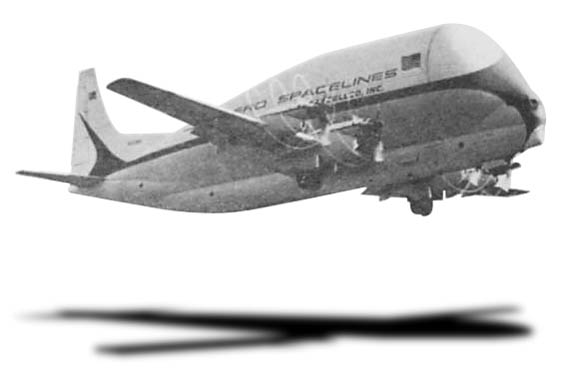
Drawings
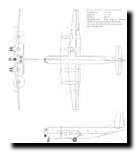 A little known fact regarding the significant role that the 377PG
and 377SG played in Kennedy's dream of getting to the moon by the end of
the 1960's. NASA was given top priority to meet this deadline. The Pregnant
Guppy's first flight was on September 19, 1962, a little over a year after
Kennedy's famous "to the moon by the end of the decade" speech.
A little known fact regarding the significant role that the 377PG
and 377SG played in Kennedy's dream of getting to the moon by the end of
the 1960's. NASA was given top priority to meet this deadline. The Pregnant
Guppy's first flight was on September 19, 1962, a little over a year after
Kennedy's famous "to the moon by the end of the decade" speech. The Pregnant Guppy was so successful that ASI built a second larger Guppy for larger, heavier loads. The 377SG Super Guppy flew for the first time just short of three years after the Pregnant Guppy on August 31, 1965. .
(30K JPG image)
 Without the Guppys, the only other way to get the Apollo rocket stages from
Califorinia to Florida was on a slow boat through the Panama Canal. The
Guppys cut not just days, but weeks and months out of the schedules. Without
the Guppys, we never would have made it to the moon by `69! Of course, this
success was also it's downfall. Once the Apollo and Skylab programs were
done, dwindling public interest in the space program forced cutbacks in
funding. In an attempt to keep the company afloat, Aero Spacelines had to
look for commercial applications for the Guppy.
Without the Guppys, the only other way to get the Apollo rocket stages from
Califorinia to Florida was on a slow boat through the Panama Canal. The
Guppys cut not just days, but weeks and months out of the schedules. Without
the Guppys, we never would have made it to the moon by `69! Of course, this
success was also it's downfall. Once the Apollo and Skylab programs were
done, dwindling public interest in the space program forced cutbacks in
funding. In an attempt to keep the company afloat, Aero Spacelines had to
look for commercial applications for the Guppy.(34K JPG image)
 The stated cruise speed for the Super Guppy was 265 MPH carrying
a 40,000 lb. payload. As seen in the fuselage cross section, ASI design
engineers took the original Guppy concept as far as was practically possible
with the 8 ft. wide floor mated to a 25 ft. diameter cargo compartment.
The constant section of the fuselage measures 30 ft. long. The overall length
of the cargo compartment is over 94 ft. ASI retained the pallet rails for
loading cargo originally used on the Pregnant Guppy.
The stated cruise speed for the Super Guppy was 265 MPH carrying
a 40,000 lb. payload. As seen in the fuselage cross section, ASI design
engineers took the original Guppy concept as far as was practically possible
with the 8 ft. wide floor mated to a 25 ft. diameter cargo compartment.
The constant section of the fuselage measures 30 ft. long. The overall length
of the cargo compartment is over 94 ft. ASI retained the pallet rails for
loading cargo originally used on the Pregnant Guppy. The red seen in this drawing is Rubilith which was used by the original graphic artist. Rubilith shows up on the printer's plate as black.
(66K JPG image)
Pictures
 This is what Clipper Constitution N1038V (c/n 15938) looked like when it
was delivered to Pan American on September 29, 1949. Later it was renamed
Clipper Hotspur and retrofitted as Super Stratocruiser in 1954. Clipper
Hotspur was stored at New York until being traded to Boeing in 1960, then
sold to Mansdorf who sold it to Aero Spacelines.
This is what Clipper Constitution N1038V (c/n 15938) looked like when it
was delivered to Pan American on September 29, 1949. Later it was renamed
Clipper Hotspur and retrofitted as Super Stratocruiser in 1954. Clipper
Hotspur was stored at New York until being traded to Boeing in 1960, then
sold to Mansdorf who sold it to Aero Spacelines.(44K JPG image)
 Parts of Boeing's YC-97J 25-2693 ( c/n 16724) Turbo-Stratocruiser,
B-377s N406Q ( c/n 15945) and N408Q ( c/n 15944) were used in the construction
of the Super Guppy. The majority of the parts including the wings with engines,
cockpit and forward fuselage section of the YC-97J were used in the construction
of the Super Guppy, but enough of N1038V was used to enable ASI to use the
Stratocruiser's "N" number for registration purposes.
Parts of Boeing's YC-97J 25-2693 ( c/n 16724) Turbo-Stratocruiser,
B-377s N406Q ( c/n 15945) and N408Q ( c/n 15944) were used in the construction
of the Super Guppy. The majority of the parts including the wings with engines,
cockpit and forward fuselage section of the YC-97J were used in the construction
of the Super Guppy, but enough of N1038V was used to enable ASI to use the
Stratocruiser's "N" number for registration purposes.(18K JPG image)
 Boeing converted two C-97s for the USAF as flying testbeds for
the then forthcomig Douglas C-133, replacing the Pratt & Whitney 4-row,
28 cylinder R4360 radials; rated at 3500 ESHP, with the new Pratt &
Whitney T-34P7 Turboprops; rated at 5500-6000 ESHP each, depending on the
source cited.
Boeing converted two C-97s for the USAF as flying testbeds for
the then forthcomig Douglas C-133, replacing the Pratt & Whitney 4-row,
28 cylinder R4360 radials; rated at 3500 ESHP, with the new Pratt &
Whitney T-34P7 Turboprops; rated at 5500-6000 ESHP each, depending on the
source cited. Conroy knew it was imperative for the new Guppy, originally dubbed B-377VPG (Very Pregnant Guppy) to use the more efficient and powerful turboprops. Jack also knew the that the C-97J Turbo-Stratocruisers were headed for retirement, and hoped to get the airframes as salvage and acquire the engines on a low cost lease.
(28K JPG image)
 During the spring of 1965, the NASA Office of the Administrator
made overtures to the Air Force, stressing the national interest, "We defintely
feel that it would be in the public interest and advantageous to the government
if these engines were made available. We would appreciate it if you would
approve the proposed lease." Conroy finally got his engines, and acceptance
tests on the now officially named B-377SG Super Guppy began before the year
was out.
During the spring of 1965, the NASA Office of the Administrator
made overtures to the Air Force, stressing the national interest, "We defintely
feel that it would be in the public interest and advantageous to the government
if these engines were made available. We would appreciate it if you would
approve the proposed lease." Conroy finally got his engines, and acceptance
tests on the now officially named B-377SG Super Guppy began before the year
was out. (40K JPG image)
 The Super Guppy was not built in stages like the Pregnant Guppy,
but was modified from the beginning into the the finished airframe with
the new upper fuselage section replacing the original C-97's as a load-bearing
structure. The cargo would be loaded from the front, making a swing nose
the most practical method of loading. Other refinements over the Pregnant
Guppy included cockpit pressurazation allowing it cruise at 285 mph, at
altitudes up to 25,000 ft to avoid bad weather.
The Super Guppy was not built in stages like the Pregnant Guppy,
but was modified from the beginning into the the finished airframe with
the new upper fuselage section replacing the original C-97's as a load-bearing
structure. The cargo would be loaded from the front, making a swing nose
the most practical method of loading. Other refinements over the Pregnant
Guppy included cockpit pressurazation allowing it cruise at 285 mph, at
altitudes up to 25,000 ft to avoid bad weather.Jack Conroy is seen here giving Werner Von Braun a tour of the Super Guppy under construction at the Aero Spacelines facilities at Van Nuys Airport in California.
(76K JPG image)
 The fuselage cargo section diameter was increased from the Pregnant
Guppy's 19 ft. to 25 ft. for the Super Guppy. The fuselage was stretched
even longer. The Super Guppy design called for a 18 ft. section added to
the rear of the fuselage and a 8 ft. section inserted in front of the wing,
bringing it's overall length to just over 141 ft.
The fuselage cargo section diameter was increased from the Pregnant
Guppy's 19 ft. to 25 ft. for the Super Guppy. The fuselage was stretched
even longer. The Super Guppy design called for a 18 ft. section added to
the rear of the fuselage and a 8 ft. section inserted in front of the wing,
bringing it's overall length to just over 141 ft.The Super Guppy is seen here on it's initial test flight on August 31, 1965 taking off from Van Nuys Airport, California. Notice the contrails coming off the propeller tips due to the humidity in the air.
(53K JPG image)
 The empennage was also extensively reworked with a 58 inch lower section
and a 48 inch upper section added to the vertical stabilizer with a larger
dorsal fin, and 48 inch extentions added to the horizontal stabilizer tips
increased stablity in flight.
The empennage was also extensively reworked with a 58 inch lower section
and a 48 inch upper section added to the vertical stabilizer with a larger
dorsal fin, and 48 inch extentions added to the horizontal stabilizer tips
increased stablity in flight. (41K JPG image)
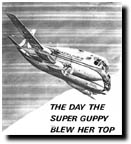 On September 25, 1965 in the clear, blue skies over the Mojave Desert, disaster
struck! There was a tremendous bang and a jolting, violent shudder as the
huge cargo aircraft hit 275 mph after starting the dive at 10,000 feet.
It felt as if a bomb had exploded in the nose section above our cockpit.
The Guppy began to shake violently. Midair collision, I thought-the worst
of all aviation disasters!
On September 25, 1965 in the clear, blue skies over the Mojave Desert, disaster
struck! There was a tremendous bang and a jolting, violent shudder as the
huge cargo aircraft hit 275 mph after starting the dive at 10,000 feet.
It felt as if a bomb had exploded in the nose section above our cockpit.
The Guppy began to shake violently. Midair collision, I thought-the worst
of all aviation disasters! This is a reprint of an article written by Lt. Col. P.G. Smith USAF (Ret.) which was published in the April 1971 issue of AIR FORCE Magazine. Super Guppy Illustration is by Gordon Phillips.
(Click on Link above to go to the 5 page article.)
 This
photo comes to us courtesy of Al Muller, USAF, Ret. who was taking part
in a flight test of a C-130. He recently uncovered this, the first color
photo of the SG's fuselage cave-in we have seen, after promising the crew
of N941 a copy and decided to share it with us, too. Thanks Al!
This
photo comes to us courtesy of Al Muller, USAF, Ret. who was taking part
in a flight test of a C-130. He recently uncovered this, the first color
photo of the SG's fuselage cave-in we have seen, after promising the crew
of N941 a copy and decided to share it with us, too. Thanks Al!(66K JPG image)
 Once the Super Guppy had proved it's flying ability, NASA wanted
to press the 377SG into service in early 1966. John C. Goodrum, Chief of
MSFC's Project Logistics Office, felt that the Super Guppy's utility was
so important, that it should be considered operational for "critical cargoes"
on a "limited basis" as soon as possible.Note in this picture the contrails
coming off the propellors caused by the moisture in the air.
Once the Super Guppy had proved it's flying ability, NASA wanted
to press the 377SG into service in early 1966. John C. Goodrum, Chief of
MSFC's Project Logistics Office, felt that the Super Guppy's utility was
so important, that it should be considered operational for "critical cargoes"
on a "limited basis" as soon as possible.Note in this picture the contrails
coming off the propellors caused by the moisture in the air. (15K JPG image)
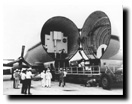 In March, 1966 Goodrum again urged operational service based on
NASA's own test pilots judgement that the aircraft was satisfactory for
transport duties. He advised NASA Headquarters that MSFC planned "immediate
utilization" of the Guppy to transport a Saturn Instrument Unit, manufactured
by IBM in Huntsville.
In March, 1966 Goodrum again urged operational service based on
NASA's own test pilots judgement that the aircraft was satisfactory for
transport duties. He advised NASA Headquarters that MSFC planned "immediate
utilization" of the Guppy to transport a Saturn Instrument Unit, manufactured
by IBM in Huntsville. (35K JPG image)
 Within a week, by special arrangement with the FAA, the Super
Guppy landed in Huntsville, and flew the IU to the Douglas plant in Huntington
Beach, California, for systems testing with an S-IVB stage. Before the end
of the month, the 377SG made a return trip, delivering a S-IVB test stage
to MSFC.
Within a week, by special arrangement with the FAA, the Super
Guppy landed in Huntsville, and flew the IU to the Douglas plant in Huntington
Beach, California, for systems testing with an S-IVB stage. Before the end
of the month, the 377SG made a return trip, delivering a S-IVB test stage
to MSFC. (39K JPG image)
 Shortly after take-off one day in 1967, the crew flying the Super
Guppy heard an ominous noise coming from the rear of the cockpit. After
making a hasty landing, while preparing to unload the S-IVB stage, they
found a gap of almost a foot wide in the nose/fuselage joint resulting in
a partial redesign in the hinge latching mechanism.
Shortly after take-off one day in 1967, the crew flying the Super
Guppy heard an ominous noise coming from the rear of the cockpit. After
making a hasty landing, while preparing to unload the S-IVB stage, they
found a gap of almost a foot wide in the nose/fuselage joint resulting in
a partial redesign in the hinge latching mechanism.(44K JPG image)
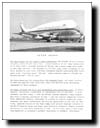 This promotional flyer was printed during Aero Spacelines' heyday.
It promotes the virtues of the Super Guppy, but also contains interesting
facts regarding the direction ASI was heading as a company, and the intended
uses for the Guppy fleet which at first was to total six aircraft. Three
built (the Mini Guppy had recently become commercially available), and three
planned.
This promotional flyer was printed during Aero Spacelines' heyday.
It promotes the virtues of the Super Guppy, but also contains interesting
facts regarding the direction ASI was heading as a company, and the intended
uses for the Guppy fleet which at first was to total six aircraft. Three
built (the Mini Guppy had recently become commercially available), and three
planned. The new improved Super Guppy was going to be utilized ferrying Douglas DC-10 fuselage sections from San Diego, California and wing section from Toronto to Douglas' final assembly plant in Long Beach, California. It also was intended to carry Lockheed L-1011 wing sections from Nashville, Tennessee to the Lockheed final assembly plant in Palmdale, California.
(69K JPG image)
 This picture was taken of the 377SG while on static display at Edwards
AFB in 1978. From this angle it is easier to see the shortened inboard propellers
and added wing center section. Another not very apparent difference between
the original and later Super Guppys is the lack of wing fairing on the original
Super Guppy. It was not needed because the shape of the fuselage kept the
propwash from flowing up the fuselage side, a feature of the later flat-sided
Super Guppys.
This picture was taken of the 377SG while on static display at Edwards
AFB in 1978. From this angle it is easier to see the shortened inboard propellers
and added wing center section. Another not very apparent difference between
the original and later Super Guppys is the lack of wing fairing on the original
Super Guppy. It was not needed because the shape of the fuselage kept the
propwash from flowing up the fuselage side, a feature of the later flat-sided
Super Guppys.(66K JPG image)
 By the time this picture was taken, on April 28, 1981, NASA owned the
Super Guppy, now renumbered N940. Before NASA would agree to purchase the
SG, they insisted on being able to inspect the aluminum skin which necessitated
removing the paint. The SG is seen in the early NASA paint scheme with the
entire fuselage painted white with a blue stripe.
By the time this picture was taken, on April 28, 1981, NASA owned the
Super Guppy, now renumbered N940. Before NASA would agree to purchase the
SG, they insisted on being able to inspect the aluminum skin which necessitated
removing the paint. The SG is seen in the early NASA paint scheme with the
entire fuselage painted white with a blue stripe. Also seen behind the SG is the Space Shuttle Columbia being unloaded from the NASA 747 carrier after completing it's first mission. Columbia is being returned to KSC to prepare it for it's next flight.
(35K JPG image)


 Seen
here are all of the mission stickers the Guppy wore proudly. On the left
(port) side of the aircraft were all of the Shuttle missions as seen in
the first photo. The second photo shows the right (starboard) side which
sported stickers from all of the rest of the missions the Super Guppy carried
loads for. Note the ever present fire bottle in the last photo.
Seen
here are all of the mission stickers the Guppy wore proudly. On the left
(port) side of the aircraft were all of the Shuttle missions as seen in
the first photo. The second photo shows the right (starboard) side which
sported stickers from all of the rest of the missions the Super Guppy carried
loads for. Note the ever present fire bottle in the last photo.(23K, 28K & 22K JPG images)

 This is the NASA Super Guppy as it stands today. All wrapped for
storage at Pima AFB in Arizona. For the purpose of scale, note the T-34
in the foreground under the Super Guppy's wing. The Super Guppy line of
aircraft all had a larger internal volume than the Lockheed C-5 Galaxy!
The Galaxy does though, have a greater lifting capacity in terms of weight.
This is the NASA Super Guppy as it stands today. All wrapped for
storage at Pima AFB in Arizona. For the purpose of scale, note the T-34
in the foreground under the Super Guppy's wing. The Super Guppy line of
aircraft all had a larger internal volume than the Lockheed C-5 Galaxy!
The Galaxy does though, have a greater lifting capacity in terms of weight.
(25K & 41K JPG images)


 These pictures show better detail of the effort taken to preserve the 377SG.
Note the tape sealing all joints. Even on the landing gear doors. The nacelles
and entire propeller assembly are also wrapped. NASA did consider bringing
the 377SG back into service for use ferrying components for the International
Space Station Program. The problem they encountered was the shortage of
available parts to maintain it's propellers.
These pictures show better detail of the effort taken to preserve the 377SG.
Note the tape sealing all joints. Even on the landing gear doors. The nacelles
and entire propeller assembly are also wrapped. NASA did consider bringing
the 377SG back into service for use ferrying components for the International
Space Station Program. The problem they encountered was the shortage of
available parts to maintain it's propellers. (43K, 40K & 41K JPG images)


 Seen here is the damage caused to the Super Guppy's rudder and gust lock
during a particularly strong desert wind storm. In the first picture the
most obvious damage is to the top of the rudder. Notice the the kink. It's
not known at this time exactly how the damage could be caused to the top
of the rudder and have it stay attached. The less apparent damage is seen
in a close up of the gust lock. In the last picture in this series, notice
the rudder, missing aileron and dust devil in the background heading towards
the Guppy.
Seen here is the damage caused to the Super Guppy's rudder and gust lock
during a particularly strong desert wind storm. In the first picture the
most obvious damage is to the top of the rudder. Notice the the kink. It's
not known at this time exactly how the damage could be caused to the top
of the rudder and have it stay attached. The less apparent damage is seen
in a close up of the gust lock. In the last picture in this series, notice
the rudder, missing aileron and dust devil in the background heading towards
the Guppy. (33K, 27K & 37K JPG images)

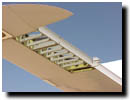
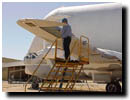 Rough first week. The Super Guppy was accidentally damaged by one of the
workers (a new guy, been there about a week) who ran into the SG with a
forklift and destroyed the left aileron and some of the wing. The museum
is in the process of repairing the damage and will put a new aileron on.
All work is being done by FAA certified mechanics (as seen in the third
picture) even though NASA has no plans to ever fly this plane again. These
pictures were taken in late May 1999. The repairs should be completed by
time you read this.
Rough first week. The Super Guppy was accidentally damaged by one of the
workers (a new guy, been there about a week) who ran into the SG with a
forklift and destroyed the left aileron and some of the wing. The museum
is in the process of repairing the damage and will put a new aileron on.
All work is being done by FAA certified mechanics (as seen in the third
picture) even though NASA has no plans to ever fly this plane again. These
pictures were taken in late May 1999. The repairs should be completed by
time you read this. (40K, 40K & 59K JPG images)
Movies
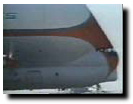 These ungainly looking aircraft
performed their duties week after week flying multi-million dollar cargoes
between NASA facilities, contractor plants, and the launch site at Cape
Kennedy. In addition to rocket stages and engines, many other pieces of
vital equipment was carried. As the Skylab orbital workshop program progressed
in the late sixties and early seventies, the Guppys ferried components such
as the Multiple Docking Adapter, the Apollo Telescope Mount and other Skylab
workshop hardware.
These ungainly looking aircraft
performed their duties week after week flying multi-million dollar cargoes
between NASA facilities, contractor plants, and the launch site at Cape
Kennedy. In addition to rocket stages and engines, many other pieces of
vital equipment was carried. As the Skylab orbital workshop program progressed
in the late sixties and early seventies, the Guppys ferried components such
as the Multiple Docking Adapter, the Apollo Telescope Mount and other Skylab
workshop hardware. Of note, the 377SG Super Guppy had a most unique manner of taking off. Notice in the video the as the Super Guppy attains flying speed, it lifts off the main landing gear first, then the nosewheel! It was the only Guppy to exibit this characteristic.
(YouTube video)
Comments or Questions? Email me
Copyright © 2006 Daren Savage
All Rights Reserved